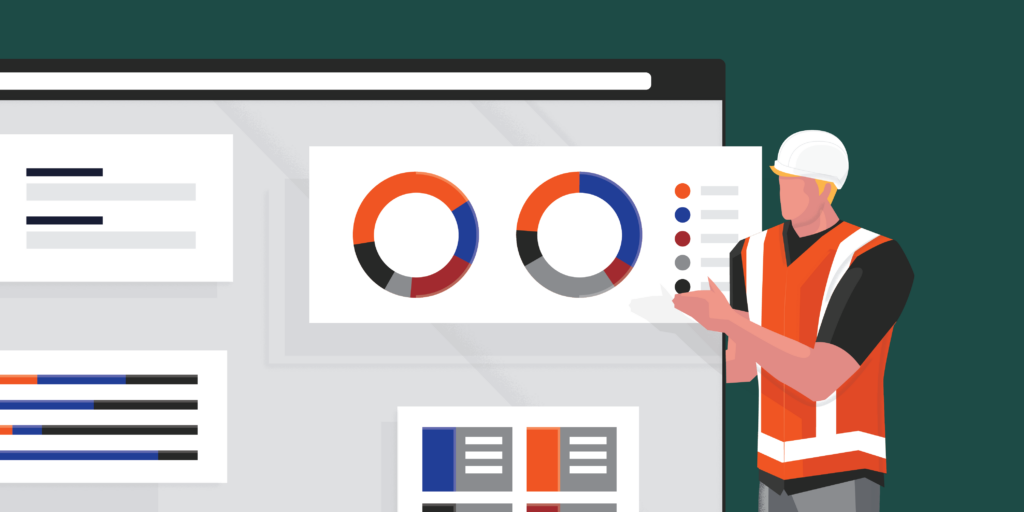— 16 min read
Construction Cost Estimating: A Step-By-Step Guide
Last Updated Jan 24, 2025
Last Updated Jan 24, 2025

Construction estimating is the process of calculating all of the required costs for a construction project, including direct costs (e.g. materials and worker wages) and indirect costs (e.g. equipment depreciation and office worker salaries). Professional construction estimators perform this essential step in the preconstruction process, which helps ensure that owners and contractors are able to complete a construction project profitably.
Estimating project costs accurately requires detailed knowledge of construction materials, specifications, techniques, codes and pricing trends. We'll walk through all of the steps professional estimators use to determine costs on a project – from reviewing a tender package all the way through accounting for contingency and profit.
Table of contents
The importance of accurate estimating
Accurate estimating is essential for the success of any construction project. Both owners and contractors rely on cost estimates to move a project from preconstruction to completion.
Without an initial understanding of a project's costs, owners cannot determine whether a project is feasible within the allotted budget. After a preliminary estimate, design or scope modifications may be required in order to alter project costs.
Contractors also depend on accurate estimates in order to prepare tenders that are competitive and profitable. A contractor that underestimates the cost of a project could be forced to cut into their own profit margin to cover project costs.
On the other hand, overestimating the actual project costs could lead a contractor to submit a tender that's too high to be selected. Even in negotiated tendering scenarios, construction estimates need to be accurate in order to strike a balance between the owner's budget and the contractor's profit.
8 steps in construction estimating
Construction estimators follow the same basic steps whether they work for a general contractor, specialty contractor or owner. When making a construction estimate, estimators are typically working to come up with an accurate price for a specific project as part of a competitive or negotiated tendering process.
In general, construction estimators follow a process that begins with reviewing tender documents, including construction specifications and contract documents, and includes steps to account for every known cost, including materials, labour, insurance and overhead. By the time an estimator is finished, they will have prepared a construction estimate that takes into account all required costs as well as a markup for profit and contingency.
1. Review tender package
The tender package contains all of the documents necessary for tendering: owner-contractor agreements, bond forms, general conditions, supplementary general conditions and construction specifications. Contractors who tender on a project are bound to complete the work laid out in the tender package, so a professional estimator spends a significant amount of time to ensure they are familiar with every aspect of the project.
Drawings are typically subdivided according to their purpose: site, architectural, structural, mechanical, electrical and more.
Both general contractors and specialty contractors will review the documents, but specialty contractors often refer only to the documents that are relevant to the work they will perform on the project.
When reviewing the tender package, construction estimators generally follow a standard process:
- Ensure that all drawings and specifications are present. Documents may be numbered sequentially or subdivided according to the preference of the design firm, so estimators take care that they have everything necessary for an accurate estimate.
- Get an overview of the project. With a quick scan through the specs, estimators get a rough idea of the scope of a project, its material needs and the quality of finishes.
- Evaluate structural requirements. By reviewing structural drawings, estimators begin to understand the material and equipment needs of the building.
- Review mechanical, electrical and plumbing (MEP) requirements. Estimators take into account the ways in which a building's MEP needs will influence the construction process for the building, including potential underground work.
- Identify any nonstandard items. Contractors tend to specialize in certain types of work, so estimators need to pay special attention to unusual floor plans, features or finishes that could affect the project's cost.
Throughout the estimating process, the estimator will continually refer back to the tender documents to ensure that their estimate encompasses every aspect of the stated specifications and requirements. By getting an overview of the documents, the estimator takes their understanding of the project through every phase of building a comprehensive and accurate estimate.
After getting an overview of the documents, an estimator for a general contractor will also subdivide the project into work packages. Work packages may be later assigned to specialty contractors, and they also serve the important purpose of ensuring that all work is accounted for and no work is assigned twice.
By reviewing the technical specifications (also called construction specifications or specs), the estimator can clearly see the scope of work according to various divisions of the Construction Specification Institute (CSI)'s MasterFormat: concrete, masonry, metals, finishes, plumbing and dozens more.
For example, the estimator may create one work package that includes the materials and labour for rough-in plumbing and another that covers windows and installation. Many such work packages will be created for a single construction project.
Dividing the project into work packages requires extreme attention to detail:
- The estimator must be careful that every aspect of the project is included in a work package, or there will be work that has not been assigned to a contractor. Later in the project, the general contractor will be on the hook for these unaccounted project costs.
- The estimator must also be sure that no project detail is included in multiple work packages, or the ultimate tender may be too high to be competitive since costs are multiplied unnecessarily.
- In cases where an aspect of the project is divided into multiple work packages, the estimator must clearly define the scope of each work package to ensure that each portion is adequately completed by the parties responsible.
Once an estimator has divided all of the work into packages, the general contractor can solicit tenders from specialty contractors for some or all of the required construction work.
2. Conduct a site visit
In some cases, a site visit is required before submitting a tender. However, a site visit is recommended in nearly all cases, as estimators can get a better sense about site conditions from a thorough visit rather than simply relying on elevation drawings or photographs of the proposed construction site.
Depending on the type of project, a specialty contractor may be less likely to perform site visits, relying instead on the documentation provided by the project's owner and general contractor.
The main purpose of a site visit is for the estimator to better understand the conditions of the site and how those are likely to influence the project costs.
For example:
- A site with poor drainage, difficult subsurface soil conditions or adjacent buildings could add complexity and cost to a project.
- A site lacking easy access could make it more difficult to maneuver equipment and materials, increasing costs.
- A site with poorly located utilities (water, electricity, etc.) could add underground work requirements that raise the cost.
During a site visit, an estimator will make notes, take photographs and collaborate with contractors to determine the potential influence the site may have on delivering the project successfully.
In addition to the site itself, the estimator should also familiarize themselves with the surrounding area if they aren't already aware of:
- Local requirements (codes, permits) or regulations (noise, working hours, parking)
- Availability of specialty contractors and construction equipment rentals
- Nearby roadways, which may need to accommodate heavy equipment or delivery vehicles
Overall, the site visit is critical for estimators, who must determine the feasibility and cost of delivering the project according to specifications in a set location.
3. Perform a material takeoff
Estimators perform a material takeoff (also called a quantity takeoff) by reviewing the construction documents and counting every item that is required for the project. Material needs are typically listed according to the way they are measured. For example:
- Quantity (e.g. doors)
- Area (e.g. drywall or flooring)
- Volume (e.g. concrete)
- Length (e.g. wire)
On large construction projects, the owner or engineer may create a bill of quantities (BOQ) to simplify the tender levelling process. This document breaks down the scope of work into an itemized list of activities and materials. Even when a BOQ is provided, most contractors still perform a takeoff to verify the quantities and identify discrepancies.
General contractors will typically do a takeoff in order to create accurate work packages – either to complete themselves or assign to specialty contractors. A specialty contractor typically reviews the specifications to perform their own material takeoff in order to ensure they have an accurate count before reaching out to suppliers and vendors.
After completing a takeoff, estimators have a comprehensive list of every material that will be required to complete the project. Additionally, estimators will use information from the takeoff to determine what equipment will be needed for each work package.
Estimators may perform a manual takeoff, which involves using paper copies of drawings, rulers, highlighters, digital measuring tools and pencils to count and measure the required materials using the specifications. Nowadays, most estimators rely on digital takeoffs using construction estimating software, which greatly speeds up the process. Nonetheless, many estimators still double-check the accuracy of the digital takeoff to ensure that their estimate is accurate.
With this information, contractors are able to work with material and equipment suppliers to get pricing information that they can use while creating a tender.
4. Solicit pricing from suppliers and vendors
With a definitive list of materials and equipment, specialty contractors begin to work with suppliers and vendors to get pricing information.
Specialty contractors have to be mindful of a few things when pricing materials:
- Material waste requires ordering extra materials. Contractors should work to eliminate unnecessary material waste, but some waste (due to material sizing, for example) is inevitable. Ideally, a contractor will be able to look back at past projects to calculate the expected amount of waste.
- Bulk pricing may dictate order sizes. For instance, a contractor may need 37,000 cubic yards for a project but find it is more cost effective to purchase 40,000 cubic yards due to supplier pricing structures.
- Quotes have limited lifespans. A specialty contractor who receives a quote for materials needs to ensure that quote is valid long enough to have their tender accepted and order materials for the project.
Contractors who do not already own equipment essential for the project will also need to reach out to equipment vendors to determine pricing for leasing or renting for the duration of the project.
Since equipment may be owned, purchased, leased or rented, contractors must determine how the project affects associated equipment costs (for example depreciation or maintenance) and build this information into their estimate.
At this point in the estimating process, contractors will have the first definitive dollar figures that need to be included as project costs. From here on out, estimators will add more direct, indirect and overhead costs to understand the true financial burden of the project from the contractor's perspective.
5. Evaluate labour requirements
With information from the takeoff, estimators can also determine the labour necessary for a project. In short, the estimator needs to specify:
- Which roles are required for the project.
- How many hours of labour will be used to complete the project.
- How productive the crew will be given data past projects and information about the current project
For specialty contractors, the crew mix usually consists of tradespeople, labourers and assistants. For general contractors, there may be project-specific managers or other professionals whose roles are considered direct costs because they are tied to one specific project.
In either case, estimators must be sure to calculate the loaded labour rate for wages rather than simply multiplying total hours by hourly wage. The loaded labour rate includes:
- Wages
- Taxes
- Insurance (including health, dental, vision or life insurance as well unemployment and worker's compensation insurance)
- Retirement contributions
- Union dues
- Sick or vacation leave
Estimators must include all of the costs associated with employing someone for the duration of a construction project, otherwise the estimate will not reflect the true cost of labour.
6. Determine insurance and bonding costs
Insurance and bonding mitigate risk for owners and contractors alike, but this benefit comes with a cost that must be included in project estimates.
Nearly all construction companies require general liability insurance, and depending on company size, scope and role, they may also have other policies, including:
- Builder's risk insurance
- Errors and omissions or professional liability insurance
- Inland marine insurance
- Commercial auto insurance
In addition to insurance, contractors working on public projects (and some commercial projects) may require a variety of construction bonds, including:
- Payment bonds
- Performance bonds
- Tender bonds
Both bonds and insurance cost money for contractors, which means that the costs must be covered by the projects they complete.
Generally speaking, bond and insurance coverage have annual costs, which contractors then spread across projects throughout the year. However, contractors may need to secure additional bonding capacity or insurance coverage for a specific job.
In any case, estimators must add the cost of bonding and insurance requirements to the project estimate.
7. Calculate overhead and indirect costs
In addition to the direct project costs, estimators must also consider the indirect field costs associated with construction as well as the overhead costs required for running a construction business.
Indirect field costs could include:
- Permits
- Trailers or temporary offices
- Site cleaning
- Professional services
- Equipment costs (depreciation, insurance, maintenance, taxes and fuel)
- Software
These costs, while not clearly laid out in the tender package, are necessary for the construction of a project. Therefore, estimators consider the rate for each of these items as well as the duration for which they'll be needed (for example, in the case of a temporary site office).
In addition to these indirect project costs, there are also general overhead costs, also known general and administrative (G&A) expenses. These are the cost of doing business – whether or not a contractor has projects to work on, they need to pay these expenses.
To ensure that the business can keep operating, contractors need to wrap overhead costs into their estimates by spreading them out over all of their projects annually.
A few common overhead expenses include:
- Rent for office space
- Administrative salaries
- Software subscriptions
- Utilities
- Taxes
- Depreciation
- Insurance
Generally speaking, estimators consider the total expected annual revenue of the company as well as the total expected annual overhead cost. With these two figures, the estimator can allocate with reasonable accuracy a specific percentage of the overhead cost to each project.
8. Account for profit and contingency
After calculating all of the costs for a construction project, the estimator will adjust the total to account for both profit margin and contingency. The profit is the fee that the contractor earns for the contract – and that money can be reinvested to continue growing the business. Contingency, on the other hand, is a portion of the contract set aside for overruns and waste – which are generally to be expected on a construction project.
Each construction business determines its own minimum attractive profit margin by considering growth goals, market conditions and more.
Similarly, contingency numbers vary significantly across the industry depending on type of construction, company size and project risk. Many construction businesses usually add anywhere from 5–10% of the contract price to account for contingency.
At the end of this process, the estimator has determined the sales price that covers all of the project costs – materials, labour, equipment, indirect field costs, overhead costs and contingency – and returns a healthy profit. With this number in hand, contractors are prepared to submit a competitive tender or begin negotiations with a project owner or general contractor.
Turning an estimate into a tender proposal
Once the sales price is determined, a tender manager will typically create a construction proposal that details everything included in the tender price in clear and concise terms. Because tender reviewers will try to ensure that everything in the scope of work is included in the tender price, it is important to use the same language shared in the construction specifications and drawings.
Using the CSI format in the estimating process makes it easy to compare each section of the tender price to a section of the specifications. Even when the tender is for a lump sum contract, using a standard format makes it easier to create a schedule of values while also improving the integration between estimating software and accounting systems.
Types of estimates
Estimators don't only prepare construction estimates for the tendering process. Different types of estimates serve different purposes depending on where it's used in the project lifecycle. For instance, an early estimate may simply provide a developer with the rough cost for a particular project, giving a sense of whether it will be viable to get financing.
Or a project in the midst of design may receive an estimate that helps determine whether finishes need to be modified to keep the project in scope for the expected budget.
There are generally five levels of detail in estimating:
| Level | Name | Description |
| 1 | Order of magnitude | Based on data from similar past projects, this type of estimate provides a very rough idea of potential costs. |
| 2 | Schematic design | Typically involves cost per square foot calculations for existing buildings with similar scope and finishes. |
| 3 | Design development | Using a tentative design and lists of expected materials and quantities, estimators provide a rough estimate for the project. |
| 4 | Construction documents | Using a nearly finished design, estimators establish a realistic budget for a project. |
| 5 | Tender estimate | Contractors use the tender documents to prepare a tender estimate, which is the cost at which they can complete the project. |
When referring to estimating, most contractors are referring to a tender estimate, which is a precise evaluation of the costs associated with a particular project with a finished design.
Construction estimating software
Construction estimating software can help streamline the process of creating a construction estimate by automating certain aspects. That said, a skilled estimator is still generally required for the process. Software tends to help with calculation and tabulation, but a talented estimator has knowledge of construction projects, prices, processes and productivity rates that dictate which costs are entered into the software.
In any case, construction estimating software has greatly reduced the burden faced by estimators – and it has made it easier to make small adjustments without having to manually recalculate entire projects.
Here are a few ways that estimator software supports the construction estimating process:
- Automated takeoffs powered by machine learning can automatically determine the quantity of materials needed by scanning project drawings and documents.
- Computer calculations reduce human error and enable estimators to make small changes to costs that are reflected across the entire estimate instantaneously.
- Productivity increases for estimators using software, as they are able to focus on the human aspects of estimating (determining which equipment is necessary, finding better pricing information, etc.) rather than the manual aspects.
Along with other construction management software, estimating software is key to increasing productivity – and thus increasing the competitiveness of future tenders.
Data-driven estimating for long-term growth
Construction estimating is a crucial process for any construction business. Financial management principles dictate that a business must understand its costs and turn a profit in order to continue to grow – and that begins with excellent estimating processes.
Financially sound construction businesses have a data-driven estimating process. Job costing data from past projects as well as detailed understanding of indirect and overhead costs enable companies to create estimates and submit tenders that are both competitive and profitable.
Categories:
Tags:
Written by
Harshil Gupta
24 articles
Harshil Gupta is a Product Marketing Manager at Procore. Backed by a stint in engineering and rich experience in growth and product marketing, he's enthusiastic about the role of technology in elevating and enabling other industries. He lives in Toronto.
View profileBruno Pasini
Bruno Pasini is a Solutions Engineer at Procore, where he develops new tools to simplify and streamline the preconstruction process. He spent nearly 20 years as an estimator and project manager for general contractors and specialty contractors in New York and California. He currently lives in San Diego.
View profileExplore more helpful resources

Equipped for Success: The Risks and Rewards of Construction Equipment
Even before written language, humans used tools to build. Contractors couldn’t have built the amazing feats seen and used in everyday life without machinery. From handheld tools to multi-storey tower...

The Percentage of Completion Method Explained
Accounting for income and expenses can present a real challenge for contractors, especially on long-term projects. The percentage of completion method is one of the most common methods of accounting...

What Is a General Contractor?
In the construction industry, a general contractor is the person or company responsible for overseeing a construction project. Property owners will typically hire general contractors to ensure a construction job...

MasterFormat: The Definitive Guide to CSI Divisions in Construction
Often referred to as the “Dewey Decimal System” of construction, the Construction Specifications Institute (CSI) MasterFormat is the industry standard in North America for organizing construction specifications. This system enables...